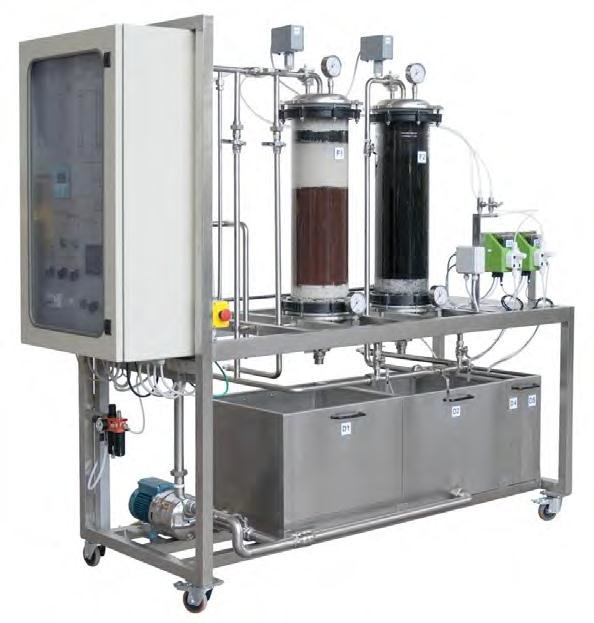Multi-Turbine Set: Pelton, Francis, Kaplan Model FM 102
Sci-tech Multi-Turbines Trainer: Pelton, Francis & Kaplan Turbines and Accessories Model 102 contain a Pelton turbine as an example for an impulse turbine and a Francis turbine as an example for a reaction turbine. The two turbine types are examined and compared with each other together with the Turbine Supply Unit and the Universal Drive and Brake Unit. The drive unit offers the possibility to set constant speeds resp. torques. Thus you can realize experiments in different realistic operating modes.
The Pelton turbine is a free-jet turbine which converts the pressure energy of the water into kinetic energy entirely in the control device. As the complete pressure difference is reduced exclusively in the nozzle, the pressure is constant in the impeller. The turbine is also known as a constant pressure turbine. The turbine power is controlled by adjusting the nozzle cross -section.
The Francis turbine converts the pressure energy of the water into kinetic energy in the control device and in the impeller. The pressure at the wheel inlet is higher than at the wheel outlet. The turbine power is controlled by adjusting the vanes in the control device.
Features
* Comparison of impulse and reaction turbines1
* Constant speeds and torques can be adjusted in combination
* Characteristics of a Turbines
* Adjustable guide vanes for setting the power output
Water turbines are turbomachines utilizing waterpower. They convert pressure and flow energy into mechanical energy and mostly are used for driving electrical generators. Water turbines can be divided into impulse and reaction turbines depending on their operating principle.
Sci-tech Multi-Turbines Trainer: Pelton, Francis & Kaplan Turbines and Accessories Model 102 contain a Pelton turbine as an example for an impulse turbine and a Francis turbine as an example for a reaction turbine. The two turbine types are examined and compared with each other together with the Turbine Supply Unit and the Universal Drive and Brake Unit. The drive unit offers the possibility to set constant speeds resp. torques. Thus you can realize experiments in different realistic operating modes.
The Pelton turbine is a free-jet turbine which converts the pressure energy of the water into kinetic energy entirely in the control device. As the complete pressure difference is reduced exclusively in the nozzle, the pressure is constant in the impeller. The turbine is also known as a constant pressure turbine. The turbine power is controlled by adjusting the nozzle cross -section.
The Francis turbine converts the pressure energy of the water into kinetic energy in the control device and in the impeller. The pressure at the wheel inlet is higher than at the wheel outlet. The turbine power is controlled by adjusting the vanes in the control device.
Turbine Supply unit provides the water supply, the pressure measurement at the turbine inlet and the flow rate measurement. In order to measure the pressure at the turbine outlet, the Francis turbine is equipped with an additional pressure sensor. Sci-tech Universal Brake and Drive Unit measures the braking torque and the speed.
The well-structured instructional material sets out the fundamentals and provides a step-by-step guide through the experiments.
The Kaplan turbine is a reaction turbine with an axial through flow. It has a high specific speed and is suitable for large water flows and small to medium heads. Therefore, the Kaplan turbine is used as a “classic” water turbine in run-of-the-river power stations.
Kaplan turbine helps to investigate the characteristic behaviour of a simple-regulated Kaplan turbine during operation. The trainer is provided with a closed water circuit with tank, submersible pump and throttle valve for adjusting the flow rate. The angle of attack and thus the power output of the impeller are changed by adjusting the guide vanes. The turbine is loaded with a wear-free eddy current brake. The speed is captured by means of an inductive, non-contact position sensor at the turbine shaft. For determining the turbine power, the eddy current brake is equipped with a force sensor for torque measurement. The pressures at the inlet and outlet of the turbine, the temperature and the flow rate are recorded with sensors. The recorded measured values are displayed digitally and processed further in a PC. The PC is used to calculate the power output data of the examined turbine and to represent them in characteristic curves.
- Operation by use of the Universal Brake and Drive Unit
- Constant torques and speeds can be adjusted with Universal Drive and Brake unit
- Transparent front panel in the turbines for observing the operating area
- Adjustable nozzle needle for setting different nozzle cross-sections (Pelton turbine)
- Adjustable guide vanes for setting different angles of incidence (Francis turbine)
- Pressure sensor at the Francis turbine for measuring the pressure at the turbine outlet
- Digital display for flow rate, pressures and temperature in Turbine Supply Unit
- Braking torque and speed measured in function of a Kaplan turbine
- Closed water circuit with submersible pump, throttle valve and tank adjustment of flow rate with throttle valve
- Loading the turbine by use of air-cooled eddy current brake impeller with fixed vanes
- Adjustable guide vanes for setting different angles of attack
- Non-contact speed measurement at the turbine shaft and force sensor at the brake for measuring the torque
- Digital display for pressures, temperature, flow rate, speed and torque.
- Determination of mechanical output
- Determination of efficiency
- Recording of characteristic curves
- Investigation of the influence of the nozzle cross-section on the power output
- Determination of power output curves at different speeds. * hydraulic power output. * mechanical power output
- Determination of the head
- Determination of turbine efficiency
- Investigation of the influence of the vane position on power output and efficiency









